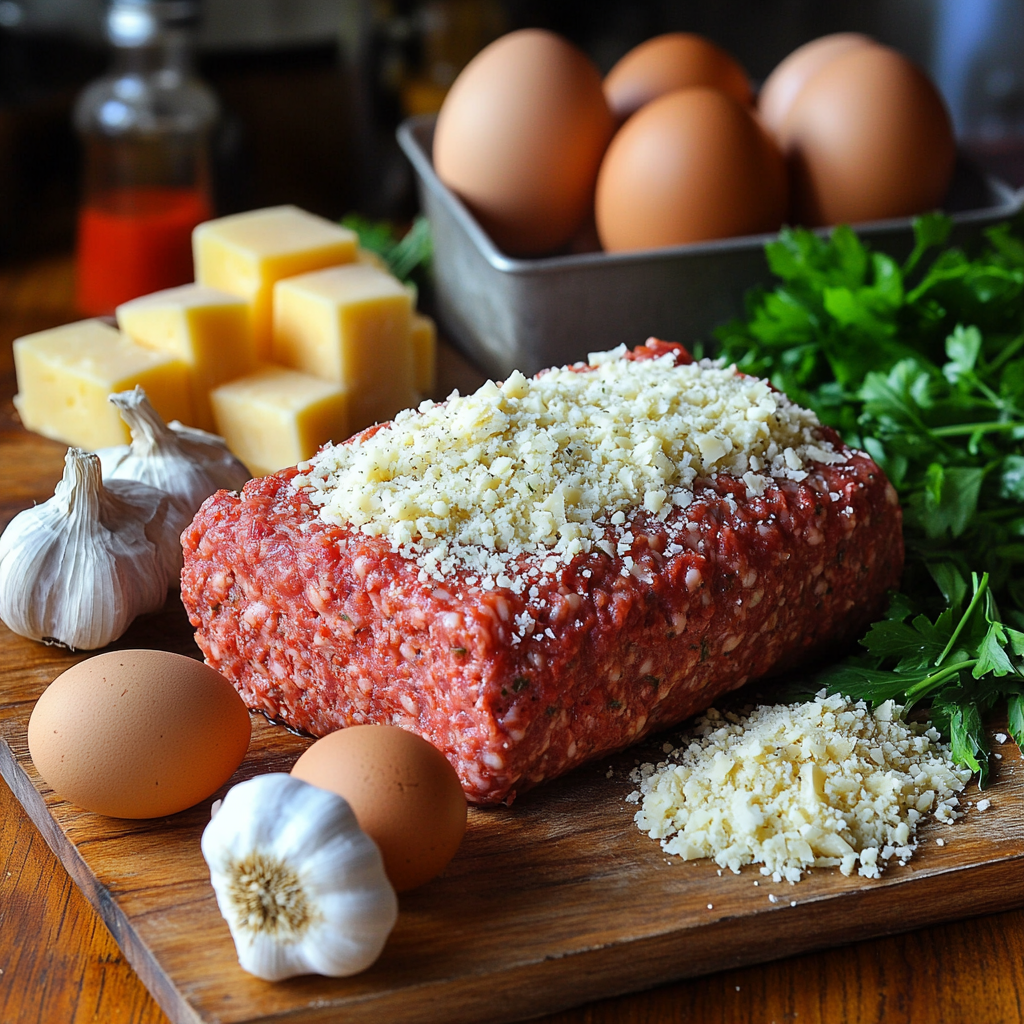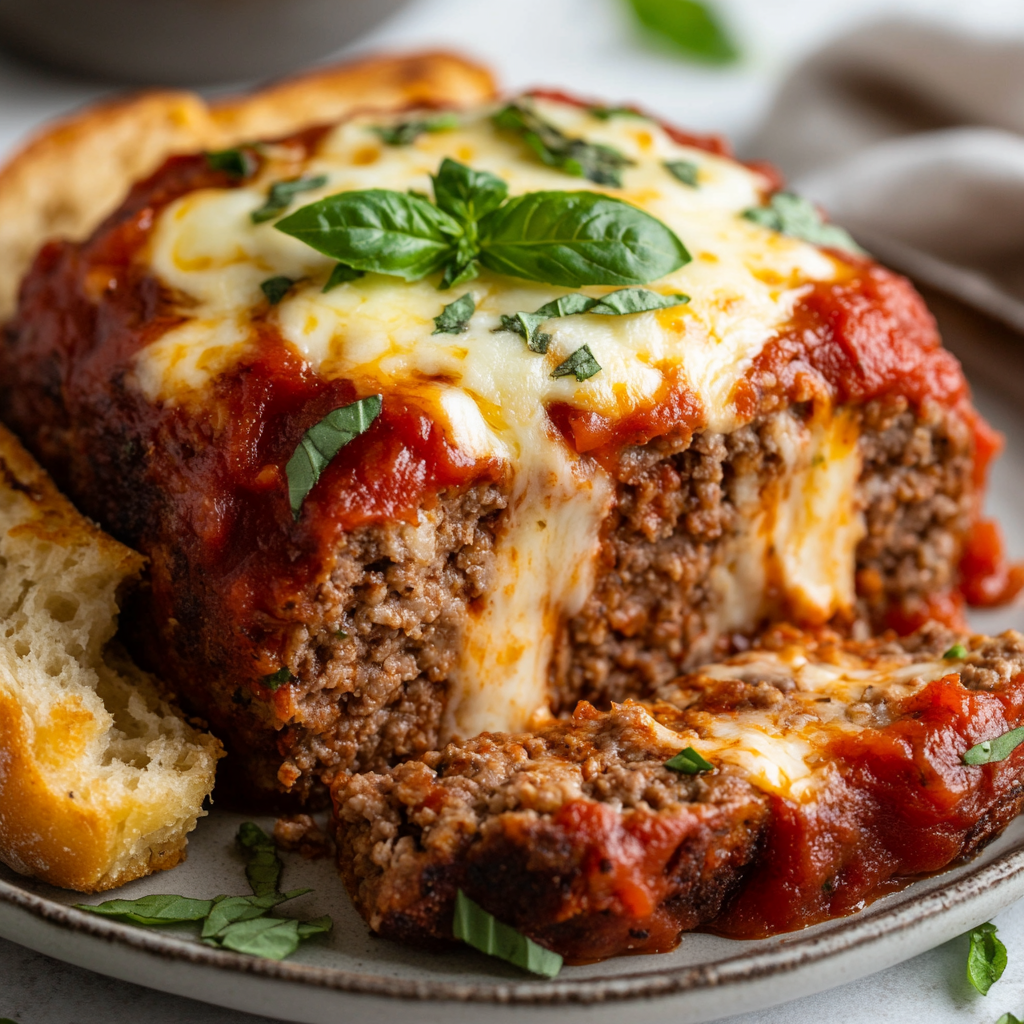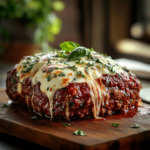Introduction
If you love classic meatloaf but want to elevate it with rich Italian flavors, you’re in for a treat! Italian meatloaf takes a traditional comfort food and transforms it into a mouthwatering dish filled with garlic, herbs, marinara sauce, and melty cheese. This recipe is juicy, flavorful, and easy to make, making it a perfect dinner option for busy weeknights or special occasions.
In this guide, you’ll learn:
- How to make the best Italian meatloaf with the perfect blend of ingredients
- Expert tips for keeping it moist and flavorful
- The best side dishes to serve with it
- Storage and reheating instructions for leftovers
- Frequently asked questions to help you master the recipe
Ready to cook? Let’s dive in!
Part 1: Ingredients and Step-by-Step Cooking Instructions
Ingredients for Italian Meatloaf
For the Meatloaf:
- 1 lb ground beef (85% lean)
- ½ lb Italian sausage (mild or spicy, casings removed)
- ½ cup breadcrumbs (Italian-style or plain)
- ½ cup grated Parmesan cheese
- 2 large eggs
- ½ cup milk
- 1 tsp salt
- ½ tsp black pepper
- 1 tsp garlic powder
- 1 tsp onion powder
- 1 ½ tsp Italian seasoning
- ½ tsp red pepper flakes (optional, for a bit of heat)
- 1 cup marinara sauce (divided)
- 1 cup shredded mozzarella cheese
For the Topping:
- ½ cup marinara sauce
- ½ cup shredded mozzarella cheese
- 2 tbsp chopped fresh basil (for garnish)
Step-by-Step Instructions
Step 1: Preheat the Oven
Preheat your oven to 375°F (190°C). Line a baking sheet with parchment paper or lightly grease a loaf pan.
Step 2: Mix the Meatloaf Ingredients
In a large bowl, combine ground beef, Italian sausage, breadcrumbs, Parmesan, eggs, milk, and seasonings. Mix gently until just combined—don’t overwork the meat!
Step 3: Shape the Meatloaf
Form the mixture into a loaf shape on the prepared baking sheet or place it into a loaf pan.
Step 4: Add the First Layer of Marinara Sauce
Spread ½ cup of marinara sauce over the top.
Step 5: Bake the Meatloaf
Bake for 45 minutes.
Step 6: Add the Cheese and Finish Baking
Remove from the oven and spread the remaining ½ cup of marinara sauce over the top. Sprinkle mozzarella cheese evenly over it. Bake for another 15 minutes, or until the internal temperature reaches 160°F (71°C).
Step 7: Let It Rest and Serve
Let the meatloaf rest for 10 minutes before slicing. Garnish with fresh basil and serve warm.
Nutritional Information (Per 100g)
| Nutrient | Amount |
|---|---|
| Calories | 230 kcal |
| Protein | 18g |
| Carbohydrates | 8g |
| Fat | 14g |
| Fiber | 1g |
Part 2: Best Side Dishes to Serve with Italian Meatloaf
Classic Italian Side Dishes
- Garlic Butter Pasta – A simple, flavorful pasta that complements the meatloaf.
- Roasted Garlic Mashed Potatoes – Creamy and packed with flavor.
- Sautéed Green Beans – Light and fresh with a garlic kick.
- Classic Caesar Salad – A crisp, tangy balance to the rich meatloaf.
- Crusty Italian Bread – Perfect for soaking up the extra sauce.

Wine Pairings
- Chianti – Pairs beautifully with the tomato-based flavors.
- Sangiovese – Enhances the herbs and spices.
- Cabernet Sauvignon – A bold choice for a hearty meal.
Part 3: Expert Tips for the Best Italian Meatloaf
- Use a mix of meats – Combining ground beef and Italian sausage enhances flavor.
- Don’t overmix – This keeps the meatloaf tender.
- Add moisture – Eggs, milk, and marinara sauce prevent dryness.
- Let it rest – This ensures juiciness when sliced.
- Use a thermometer – Aim for 160°F (71°C) internal temperature.
Part 4: Storage, Reheating, and Freezing Tips
How to Store
- Refrigerator: Store in an airtight container for up to 4 days.
- Freezer: Wrap tightly and freeze for up to 3 months.

Best Reheating Methods
- Oven: Bake at 350°F (175°C) for 15-20 minutes.
- Microwave: Heat slices on medium power with a damp paper towel.
- Stovetop: Sear slices in a non-stick skillet for a crispy edge.
Part 5: Expert Tips for the Best Italian Meatloaf
Want to take your Italian meatloaf to the next level? Follow these expert tips to ensure it turns out juicy, flavorful, and absolutely irresistible every time!
1. Use a Mix of Meats for Maximum Flavor
A combination of ground beef and Italian sausage creates the best texture and flavor. The sausage adds a slightly spicy, herby kick that takes the dish to another level.
2. Don’t Overmix the Meat
Overworking the meat mixture can result in a dense, tough meatloaf. Gently mix until just combined—this keeps it light and tender.
3. Add Moisture for a Juicy Meatloaf
Ingredients like milk, eggs, and marinara sauce help lock in moisture. Skipping these can lead to a dry meatloaf, so be sure to include them!
4. Let It Rest Before Slicing
After baking, allow the meatloaf to rest for at least 10 minutes before slicing. This helps the juices redistribute, ensuring each slice stays moist and flavorful.
5. Try a Stuffed Version
Want even more cheesiness? Instead of just topping the meatloaf with cheese, stuff it with mozzarella or provolone for a gooey surprise in every bite.
6. Use a Meat Thermometer for Perfect Doneness
To avoid overcooking or undercooking, use a meat thermometer. The ideal internal temperature is 160°F (71°C) for beef and pork mixtures.
7. Customize with Different Toppings
While marinara sauce is the classic topping, you can also experiment with:
- Pesto for a fresh, herby twist
- Sun-dried tomato spread for extra richness
- Spicy arrabbiata sauce for a bold kick
Common Mistakes to Avoid
| Mistake | How to Fix It |
|---|---|
| Overmixing the meat | Mix gently to keep it tender |
| Using lean meat only | Add some fatty sausage for moisture |
| Skipping the resting time | Let it sit to retain juices |
| Not seasoning enough | Use garlic, basil, oregano, salt, and pepper generously |
| Baking at too high a temp | Stick to 375°F (190°C) for even cooking |
By following these pro tips, your Italian meatloaf will turn out flavor-packed and perfectly juicy every single time!
Part 6: Storage, Reheating, and Freezing Tips
Got leftovers? No problem! Italian meatloaf stores beautifully and tastes just as delicious the next day. Whether you want to refrigerate, freeze, or reheat it, follow these simple tips to keep it moist and flavorful.
How to Store Italian Meatloaf
Refrigerator Storage
- Let the meatloaf cool completely before storing.
- Wrap it tightly in plastic wrap or aluminum foil, or place it in an airtight container.
- Store in the refrigerator for up to 4 days.
Freezer Storage
- For longer storage, Italian meatloaf freezes well!
- Wrap the meatloaf tightly in plastic wrap, then place it in a freezer-safe bag or airtight container.
- Label it with the date and freeze for up to 3 months.
Best Ways to Reheat Italian Meatloaf
Oven (Best Method for Keeping It Juicy!)
- Preheat the oven to 350°F (175°C).
- Place the meatloaf in a baking dish and cover it loosely with foil to prevent drying.
- Bake for 15-20 minutes or until heated through.
Microwave (Quick Option)
- Place a slice on a microwave-safe plate and cover with a damp paper towel.
- Heat on medium power for 1-2 minutes, checking frequently to avoid drying out.
Stovetop (For a Crispy Edge!)
- Heat a non-stick skillet over medium heat.
- Add a slice of meatloaf and cook for 2-3 minutes per side until warmed through.
Can You Freeze Uncooked Italian Meatloaf?
Yes! If you want to prepare your meatloaf in advance, follow these steps:
- Shape the meatloaf as usual, but don’t bake it.
- Wrap it tightly in plastic wrap, then place it in a freezer bag.
- Freeze for up to 3 months.
- To cook from frozen, thaw overnight in the fridge and bake as directed.
Part 7: Frequently Asked Questions (FAQs) About Italian Meatloaf
Still have questions about making the perfect Italian meatloaf? Here are some common FAQs and expert answers to help you master this delicious dish.
1. What’s the secret to keeping meatloaf moist?
The key to a juicy meatloaf is adding moisture-rich ingredients like eggs, milk, and marinara sauce. Also, using a combination of ground beef and Italian sausage adds extra fat, which keeps it from drying out.
2. Can I make Italian meatloaf without breadcrumbs?
Yes! If you need a gluten-free option, substitute breadcrumbs with:
- Crushed gluten-free crackers
- Oats (blended into a finer texture)
- Almond flour
These alternatives help bind the meat while keeping it tender.
3. Why is my meatloaf falling apart?
If your meatloaf is crumbling, it may need more binding ingredients like eggs and breadcrumbs. Also, avoid overmixing the meat, as this can weaken its structure.
4. Can I prepare meatloaf ahead of time?
Absolutely! You can:
- Prepare the mixture, shape it, and store it in the fridge for up to 24 hours before baking.
- Freeze the uncooked meatloaf and bake it fresh when ready.
5. What’s the best cheese for stuffing Italian meatloaf?
Mozzarella is the classic choice, but you can also try:
- Provolone for a sharper taste
- Ricotta for an extra creamy texture
- Fontina for a buttery, mild flavor
6. How do I know when meatloaf is fully cooked?
The safest way to check doneness is with a meat thermometer. The internal temperature should reach 160°F (71°C).
7. What’s the best marinara sauce to use?
For the best flavor, use:
- Homemade marinara sauce
- A high-quality store-bought sauce with no added sugars
- Arrabbiata sauce if you like a spicy kick
8. Can I make mini meatloaves instead of one large loaf?
Yes! To make individual mini meatloaves, divide the mixture into small portions and bake at 375°F (190°C) for 20-25 minutes.
9. What’s the best way to reheat meatloaf without drying it out?
The oven method is best. Reheat at 350°F (175°C) for 15-20 minutes with a little extra marinara sauce on top to keep it moist.
10. Can I use turkey instead of beef?
Yes! You can make a lighter version by using ground turkey or chicken. Just add a bit of olive oil to keep it from drying out.
External Links for Reference
- How to Make Homemade Marinara Sauce – Learn how to make a flavorful sauce.
- The Best Italian Cheeses for Cooking – Explore different cheeses for your meatloaf.
- How to Properly Store Meatloaf – Food safety guidelines for storage.
Italian Meatloaf
If you love classic meatloaf but want to elevate it with rich Italian flavors, you’re in for a treat! Italian meatloaf takes traditional comfort food and transforms it into a mouthwatering dish filled with garlic, herbs, marinara sauce, and melty cheese. Juicy, flavorful, and easy to make, this recipe is perfect for busy weeknights or special occasions.
- Prep Time: 20 minutes
- Cook Time: 60 minutes
- Total Time: 1 hour 20 minutes
- Yield: 6 servings 1x
- Category: Dinner
- Method: Baking
- Cuisine: Italian-American
Ingredients
-
1 lb (450g) ground beef (85% lean)
-
½ lb (225g) Italian sausage (mild or spicy, casings removed)
-
½ cup (50g) breadcrumbs (Italian-style or plain)
-
½ cup (50g) grated Parmesan cheese
-
2 large eggs
-
½ cup (120ml) milk
-
1 tsp salt
-
½ tsp black pepper
-
1 tsp garlic powder
-
1 tsp onion powder
-
1½ tsp Italian seasoning
-
½ tsp red pepper flakes (optional)
-
1 cup (240ml) marinara sauce (divided)
-
1 cup (113g) shredded mozzarella cheese
For the Topping:
-
½ cup (120ml) marinara sauce
-
½ cup (57g) shredded mozzarella cheese
-
2 tbsp chopped fresh basil (for garnish)
Instructions
Preheat your oven to 375°F (190°C). Line a baking sheet with parchment paper or lightly grease a loaf pan.
In a large bowl, combine ground beef, Italian sausage, breadcrumbs, Parmesan, eggs, milk, salt, pepper, garlic powder, onion powder, Italian seasoning, and red pepper flakes. Gently mix until just combined.
Form the mixture into a loaf shape on the prepared baking sheet or press into a loaf pan.
Spread ½ cup of marinara sauce evenly over the top of the meatloaf.
Bake for 45 minutes.
Remove the meatloaf from the oven. Top with the remaining marinara sauce and shredded mozzarella. Return to the oven and bake for an additional 15 minutes, or until the internal temperature reaches 160°F (71°C).
Let the meatloaf rest for 10 minutes. Garnish with chopped fresh basil before slicing and serving.
Notes
-
Do not overmix the meat; it keeps the meatloaf tender.
-
Use a mix of ground beef and Italian sausage for maximum flavor.
-
For a stuffed version, add extra mozzarella in the center before shaping.
-
Letting the meatloaf rest after baking helps it retain juices.
Nutrition
- Serving Size: per 100g
- Calories: 230 kcal
- Sugar: 3g
- Sodium: 450mg
- Fat: 14g
- Saturated Fat: 6g
- Unsaturated Fat: 7g
- Trans Fat: 0.3g
- Carbohydrates: 8g
- Fiber: 1g
- Protein: 18g
- Cholesterol: 65mg
Keywords: Italian meatloaf, meatloaf recipe, easy meatloaf, cheesy meatloaf, beef and sausage meatloaf, family dinner, comfort food, baked meatloaf


